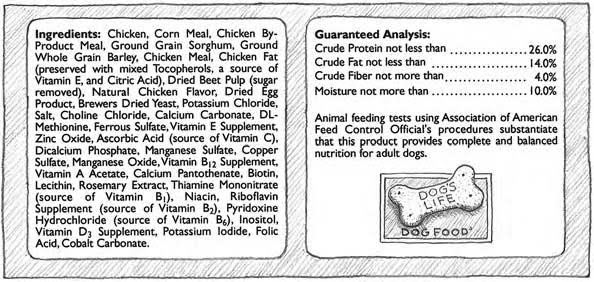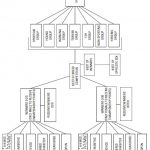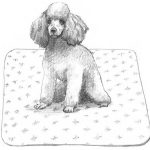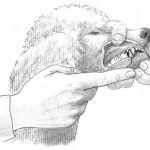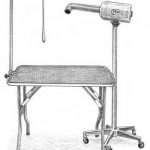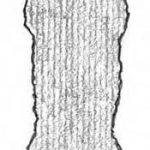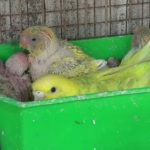In This Chapter
- Reading about nutrients on a dog food label
- Finding out all about Poodle meals, snacks, and treats
- Setting up a feeding routine
- Altering your Poodle’s diet as time goes by
- Staying away from dangerous foods
At first, you feed your Poodle whatever food your breeder recommends, but as time goes by, you may decide to change to another brand of food. This chapter discusses your choices when it comes to offering your dog a balanced diet. I also explain how to create a feeding routine, show you how to alter your Poodle’s diet as he grows, and point out foods that all Poodles must avoid.
Knowing the Nutrients that Your Poodle Needs
Although you may think of your Poodle as a carnivore, needing primarily protein and fat in the form of meat, that’s only half right. Dogs also need carbohydrates, vitamins, and minerals to stay healthy.
Technical Stuff
In the wild, carnivores eat “the good stuff” first, which isn’t muscle meat and fat, but the internal organs. They eat the stomach and intestines and get vegetable matter from that, and they eat heart, liver, kidneys, and brains, which are full of vitamins and minerals, as well as protein. (Sounds tasty, doesn’t it?)
You can cruise the pet aisle at the supermarket and find a readymade food that meets your Poodle’s dietary requirements. Whether you decide to go with dry, canned, or semi-moist dog food (all of which I cover later in this chapter), read the label so you understand just what your Poodle is getting at mealtime. Figure 7-1 shows a typical dog food label.
Figure 7-1: A label tells you a lot about the nutrients in your Poodle’s food.
The first five ingredients are important. Ingredients are listed by quantity, from most to least. Somewhere in those five, and preferably in first place, should be a meat protein. This ingredient can be beef, chicken, turkey, or lamb. Meat byproducts may also be listed in the first five ingredients. Byproducts may not sound too appetizing to us, but your dog loves them. Byproducts include organ meat, and they’re full of vitamins and minerals for your dog.
Next on the label is a grain filler. Manufacturers use grain to add bulk to the food. A grain filler is fine, as long as more meat than filler is in the food. Filler grains are corn, wheat, soy, and rice. Fillers supply carbohydrates and smaller amounts of protein and vitamins. You may want to take note of the following filler facts:
– Corn is in most dog foods because it’s cheap.
– Wheat and soy, along with corn, may cause allergies, so pay attention to how your dog reacts to his food.
Warning!
If he’s scratching or biting and chewing at his paws, he may be allergic to something in his food. In this instance, you should consider trying another brand of food that uses a different grain or protein source. If the problem continues, consult your veterinarian. (See Chapter Considering Common Poodle Conditions for more on allergies.)
– Rice causes fewer allergic reactions and has become a popular filler for that reason.
Vitamins and minerals, such as B vitamins, vitamin A, vitamin C, vitamin D, calcium, iron, and zinc, are frequently added to dog food to make the food a complete and balanced diet for your dog.
The meaning of AAFCOOn every dog food label you examine, you can see the acronym AAFCO. That stands for American Association of Feed Control Officials, the governing body for all animal feed products. AAFCO sets the guidelines for pet food manufacturers. For instance, under AAFCO regulations, byproducts may not include hair, horn, teeth, hooves, feathers, or manure. AAFCO regulations also state that all ingredients must be listed, and they must be in order, from the largest amount to the smallest, including preservatives. Keep in mind, though, that AAFCO regulates quantity, not quality. It’s still up to you to decide which food offers the best nutrition for your Poodle. For more information about AAFCO, check out www.aafco.org. |
Fat in dog foods usually comes from the protein source. A food containing chicken will have chicken fat. This isn’t always true, but the label will specify the type of fat, such as beef, chicken, or lamb.
You may also see preservatives listed on the label. Preservatives are added to the food to give it a longer shelf life and to keep the food from spoiling.
Your dog food label includes a guaranteed analysis, which tells you the percentage of ingredients, such as protein, fat, and fiber. The more active your dog, the higher protein content you want. If your dog is overweight, consider foods with less fat. The food may have a higher percentage than the analysis lists, but it can’t have less.
Dishing Out Main Meals
Snacks and training treats are a part of your dog’s daily diet, but most of your Poodle’s nutritional needs are met during his scheduled meals. In the following sections, I go over several options for a Poodle’s regular meals.
Choosing among dry, canned, and semi-moist foods
Most Poodle owners opt to feed their pooches dry, canned, or semi-moist food. In the following sections, I explore the pros and cons of each of these doggy dishes.
Tip
Many foods may come in separate varieties for puppies, adults, or seniors. Puppy foods tend to have more protein, and senior foods contain both less protein and less fat. Even adult foods may vary as far as protein goes. You can find foods for active dogs that contain more protein and fat than food for the average pet.
Dry food
Dry food is a popular option for many dog owners. It’s relatively inexpensive and keeps for a long time. If you have multiple dogs, this option is the easiest and cheapest. Dry food gives your dog something to chew, if he doesn’t just inhale his food like my male, and if you decide to free feed your dog, that is, leave food out all the time, dry food won’t spoil. (See “Having food available all the time,” later in this chapter, for more about free feeding.)
Warning!
Dry food varies in quality. While the cheap brands may have the necessary nutrients (listed on the label), these foods may not always be in a form that is readily absorbed by your Poodle. They may keep a dog alive, but many are barely adequate nutritionally.
Tip
Kibble size, that is, the size of each individual piece of food, does make a difference to your Poodle. Small dogs like Toy Poodles need more calcium and phosphorus than large dogs like Standard Poodles and have higher energy needs than large dogs. They can get what they need with a smaller, denser piece of food.
Canned food
Dry food may be the choice of humans, but if your Poodle could talk, he’d probably vote for canned food. Canned food smells great to your dog — if not to you — and tastes great, too (at least that’s what my dogs tell me). Most canned foods have a higher meat content by volume and less grain filler. (See the previous section for more on dog food ingredients.)
Canned foods are more expensive. And after you open the can, you have to use it within a day or two and refrigerate the unused portion. Canned food can spoil if you leave it out all day, so it’s not a good choice for free feeding.
Tip
If you like the convenience and price of dry food, but your Poodle adores canned, consider adding a bit of canned food to the dry when you feed your dog. Just mix in a spoonful or two of the canned, and your Poodle can get the great flavor he loves at a fraction of the price. Another trick is to soak dry food in beef or chicken broth to make it more appealing.
Semi-moist food
Semi-moist food is the most expensive of the three types of food. The shape of semi-moist food generally looks like people food — like a hamburger patty. While this food may have the vitamins and minerals your dog needs, it may also have added food coloring, sugar, flour, and preservatives to keep the patty in a desirable shape. The sugar and flour are empty calories your dog doesn’t need. Semi-moist food may also contain more artificial preservatives.
Tip
Semi-moist food does have the advantage of coming in little pouches, so it’s convenient if you’re traveling.
Doing some home cooking
If you want to feed your Poodle a natural diet but aren’t comfortable with feeding raw (see the following section), you can cook for your dog. Puppies, as well as adult Poodles, can thrive on a properly balanced home-cooked diet.
Tip
To give your Poodle the benefits of fresh meat and bones, you can feed him chicken, but you need to kill all the harmful bacteria and soften the hard bones that splinter or become impacted in the dog’s digestive tract. Here are some ways to provide healthy protein:
– Put chicken legs in a slow cooker, cover with water, and cook on low for 24 hours. This reduces the bones to mush.
– Cook chicken wings in a pressure cooker, with 15 pounds of pressure for 75 minutes for a pint jar of wings.
You also need to cook up vegetables and grains and add supplements to make sure your home cooking offers a balanced diet. Oatmeal, barley, and rice are all good grains to use, and you can use a wide range of vegetables. (Just stay away from onions as they can cause hemolytic anemia.) Cooking the vegetables helps break down the cell walls so your dog gets the benefits; otherwise, dogs can’t break down the cellulose. Add vitamin supplements after you’ve cooked the food (liquid baby vitamins are an easy way to add vitamins). Some people like to feed meat at one meal and the veggies and grains at another; others mix everything all together. As with raw, you can freeze individual portions for later use.
Remember
Before you decide on either a raw or a home-cooked diet for your dog, make sure you have the time, as well as the desire. Cooking up large batches and freezing them saves time, but remember that this isn’t a short-term project. You’re cooking for the life of your Poodle, which can be anywhere from 14 to 18 years. Also, you may need to invest in a freezer.
Getting the scoop on raw foods
BARF is the unfortunate acronym for a raw food diet. It stands for Bones And Raw Food, or Biologically Appropriate Raw Food. Either way, it means you reject processed dog foods in favor of raw foods, similar to what a wild canine eats. In the following sections, I help you evaluate whether a raw diet is appropriate for your Poodle and explain how to start one safely.
Deciding whether to use a raw diet
People are either enthusiastic supporters or totally against feeding raw. Those devotees who feed raw report healthier, more-energetic dogs with whiter teeth and shinier coats. On the other hand, critics say that the harmful bacteria in uncooked food present a danger. Supporters say that the dog’s short digestive system doesn’t let those bacteria stay in the body long enough to cause harm.
Warning!
While many feeders of raw food are convinced their dogs are healthier on this diet, to date, no controlled research indicates that this is the case. You should give serious consideration to the risk/benefit ratio before deciding on this or any other diet for your Poodle. Both salmonella and E. coli may be in raw foods, and even if your dog can handle these, you run the chance of spreading them to your own foods if you don’t maintain strict sanitary conditions when preparing the food. Always clean preparation surfaces thoroughly and wash all utensils in warm, soapy water.
If you decide to try the BARF diet with your Poodle, remember that it’s more than just meat and bones. No matter what kind of food you give your dog, the diet still needs to be balanced. People who feed raw may add supplements (such as B vitamins, vitamin C, vitamin E, fish oil, flaxseed oil, cod liver oil, kelp and alfalfa powders, and unsulphured blackstrap molasses) to their dog’s meals, and they also feed the pooches a variety of foods.
Remember
Talk to your veterinarian before starting a raw food diet. If she approves, she may have suggestions for making the diet balanced. If she’s against raw diets, but you’re going to feed raw anyway, have her do a blood scan on your Poodle before your start, and then schedule one every six months. A blood scan allows your vet to monitor the effects of the diet, and you continue working with her, which may be a better option than finding a new vet.
Putting your Poodle on a raw diet
Typically, dogs on a raw diet are fed raw, meaty bones each morning. If you have a Toy Poodle, that may be one chicken neck. A Miniature may eat two or three. For a Standard, you can use something larger, like turkey necks. The evening meal alternates between muscle meat, organ meat, and vegetables. If you start your puppy on raw foods, crush or grind bones to make chewing, swallowing, and digesting easier.
Remember
The “raw” in a raw diet refers to the meat and bones. Vegetables need to be processed in a blender or food processor or lightly cooked to break down the cellulose. Dogs don’t produce the necessary enzymes to digest cellulose, so, unless you start the process, the vegetables pass through your dog’s system untouched. If you’re adding grains, like rice or oatmeal, to the diet, cook those first. Cook potatoes as well, if you want to add a few for variety.
Tip
Most people who feed raw cook up a large batch of vegetables and grain and then freeze individual portions. You need freezer space for those individual portions, as well as space for the raw foods.
Find a good butcher who can supply you with the meaty bones and organ meats that you need. If you live in a larger city, a pet supply shop in your area may stock frozen raw bones, turkey necks, tripe, and packages of raw meat mixed with vegetables.
Steering clear of table scraps
Before the advent of commercial dog foods, many dogs lived on table scraps. Today, people have a better understanding of what a dog needs for a balanced diet, and table scraps aren’t the recommended choice for your dog.
Warning!
It’s fine to add a bit of lean meat or a few vegetables to your Poodle’s dinner bowl. Just make sure that you’re just adding a tasty treat and not making those leftovers your dog’s entire meal. As much as you consider your dog a part of the family, a dog isn’t a person, and he needs a different diet to stay healthy.
Keeping water, water everywhere
Fresh, clean water is as important a part of your Poodle’s diet as the vitamins and minerals he needs. Keep a clean bowl full of water where your dog has access to it at all times. I keep a bowl in the kitchen, and my dogs always have fresh water in their crates, too.
If you have an outdoor run or you’re in the yard playing with your Poodle, make sure that he has water available. In hot weather, I increase the number of ice cubes I give my dogs as well. They may not stop to have a drink, but they always happily munch down an ice cube or two.
Tip
Check the water level in bowls during hot weather. Poodles enjoy playing in water and may paw and splash in the bowl. You may also want to set the bowl on a folded bath towel to catch the overflow.
Giving Snacks and Treats Smartly
Technically, your Poodle will do just fine with his regular meals, eating nothing in between, but realistically, most people feed their dogs goodies at other times. Food rewards are useful for training, and resisting those pleading eyes when you’re enjoying a bowl of popcorn in front of the television can be on the verge of painful. In the following sections, I give you some tips on feeding snacks and treats to your Poodle.
Giving out snacks
It’s easy to say that dogs should eat their regular meals, and that’s it. No added goodies are necessary. Easy to say, but very hard to follow. My dogs all get a dog biscuit when they go into their kennels, a piece of carrot after breakfast, a morsel of cheese at lunchtime, and, if we have pizza, they’re in line for a bite of crust. My male is passionate about mashed potatoes, and who am I to deny those pleading brown eyes a spoonful of potatoes?
Remember
It’s easy to see that snacking can get out of hand. You need to set some rules, like the following:
– Snacks and treats should never make up more than ten percent of your dog’s total diet.
– Avoid too much people food. A sliver of turkey at Thanksgiving is fine, but hold off on the rich gravy. A spoonful of canned pumpkin makes a fine low-cal treat, but pumpkin pie can be too rich and spicy. Almost any vegetable adds a low-calorie treat to the food dish. (Check out “Avoiding Certain Foods,” later in this chapter, for people food no-nos.)
Trying treats
Most dogs eat anything and everything, so it’s up to you to provide snacks that are both good and tasty. I cover several types of treats in the following sections.
Tasty rewards
The pet aisle in the supermarket is lined with all kinds of doggy treats, from hard, crunchy biscuits to treats stuffed with cheese or peanut butter to chewy jerky-type treats. Any or all of these morsels make good rewards for your Poodle, and some of the softer treats can be broken down into a good size to use when training (which I cover in Chapter
Housetraining Made Easy). You want to give a lot of rewards, not a lot of calories, when you train, and your dog is perfectly happy with smaller morsels.
The softer treats, especially, may have more added sugars, salt, and preservatives, so make treats a treat, not a full meal.
Tip
Many types of rubber toys on the market have a place to put a treat. Some even come with a chewy treat. These toys offer play and chewing exercise. A great combo for you and your Poodle!
Rawhide and nylon chews
Rawhide chews are also on the shelf. Many dogs enjoy rawhide chews and never have a problem. In others, the rawhide can sit in an indigestible mass in the stomach or can block the intestines.
Supervise chewing. If your dog is the kind who bites off chunks and swallows, give him a different kind of chew toy. I prefer the rawhide bones that are made of shredded rawhide. The bits of shredded rawhide are too small to do damage, but even those should be given sparingly, especially if you have a dog who chews rapidly.
For long-lasting chewing pleasure, my dogs like the nylon bones. The tiny pieces of nylon pass harmlessly through the system, and the bones are too hard for the dogs to bite off chunks.
Warning!
If your dog is a very vigorous chewer, he could crack a tooth on a nylon bone.
Establishing a Feeding Routine
In the following sections, I discuss feeding your Poodle at regular times, choosing to have food available all the time, and portioning food correctly.
Feeding at set times
If you’re feeding a prepared commercial food, the number of feeding times doesn’t make much difference, but raw diets require twice-daily feedings. No matter what you choose to feed your Poodle, he expects his meals regularly. You decide whether you feed your adult once or twice a day or whether you plan to leave food out all the time (see the next section).
Remember
Consistency is key! Dogs are creatures of habit, and your dog will anticipate his meal, which means that his digestive juices will begin to flow. An advantage to feeding at regular times, whether once or twice a day, is that if your Poodle isn’t feeling well and skips a meal, you know right away.
I prefer twice-a-day meals for all sizes of Poodles. Part of that reason is my feelings. I’d want two meals a day (at least!), so I feel better giving my dogs two. The other part of my reasoning is practical. With Standards, two meals a day can help to prevent bloating, and with Toy dogs, it prevents dangerous dips in blood sugar levels. Toy dogs have a higher metabolism rate than larger dogs as well as smaller stomachs. One meal a day may not give a Toy the nutrition or energy he needs. Twice a day also makes it easier to sneak medications into the food as well.
Having food available all the time
Free feeding, or leaving the food down all day, may work well if you have one dog. If you have more than one, it’s harder to keep track of how much food each dog is getting. The more dominant dog may be gobbling it all. Also, you can’t really free feed canned, cooked, and raw foods, because they spoil if they sit out all day.
Warning!
If you do decide to free feed, still ration your Poodle’s food. Put down a set amount each day (see the following section for details). When it’s gone, it’s gone. Don’t keep refilling the bowl. That’s a good way to get a very pudgy Poodle, and an overweight dog runs a greater risk of arthritis, heart disease, and diabetes.
Knowing how much food to feed
If you read the label on your dog’s food, you can generally find a chart suggesting how much food you should give your dog, based on his weight. You can start with that, but it’s been my experience that I need to feed less than the recommended amount.
Depending on weight, activity, and age, different size Poodles eat different amounts:
– A Toy may eat between 1⁄2 and 3⁄4 of a cup a day
– A Miniature about one cup a day
– A Standard between two and three cups a day
Whatever you feed for an entire day of meals is how much food you would put down if you were free feeding your dog. For instance, if your Standard Poodle eats one cup of food in the morning and another cup at night, you’d put down two cups of food all at once for free feeding. If you feed multiple dogs and the system works for you, add all your daily amounts and offer the food in several dishes.
Changing Your Poodle’s Diet as He Grows
You probably start out by feeding your Poodle puppy a specially formulated food only for puppies, but you may wonder just when to make the switch to adult food. For a while, the trend was to feed a puppy food for a full year, but then it turned out that larger dogs do better growing slower. Rapid growth can lead to joint problems, so most breeders and veterinarians recommend making the switch at six months, or even three months of age. Even for Toys and Miniatures, it’s fine to start feeding adult food at six months of age, and some people never feed puppy food at all.
Tip
If your Poodle, no matter what his size, is a house pet getting an average amount of exercise, regular adult food should be just fine. If, however, you’re competing in dog shows or performance events (see Chapter Showing Off and Enjoying Your Poodle’s Talents for more about these events), consider a food with a higher protein level to match the energy your dog is expending.
After age seven or so, your Poodle may show signs of aging. Even if he still seems as active as ever, his metabolism can be changing. Talk to your veterinarian. She may run blood tests and, depending on the results, suggest a senior food. Senior foods typically have less protein and fat, and may include supplements such as glucosamine and chondroitin, as well as omega-3 fatty acids to help control arthritis. A senior food may also have omega-6 fatty acids for healthy skin and coat. See Chapter
Easing Your Senior Poodle into the Golden Years for more about easing your senior Poodle into the golden years.
Avoiding Certain Foods
Warning!
Your Poodle can share a lot of people food with you, but several foods can cause serious problems and can even be fatal. Here’s a list of some foods to keep away from your Poodle:
– Alcohol: No alcoholic beverages, ever. A drunken dog isn’t funny, and even a small amount of liquor can cause alcohol poisoning, which can kill your dog.
– Chocolate: Hold the bon-bons when it comes to treating your dog. Chocolate contains theobromine, which can be fatal. The darker the chocolate, the greater the danger, so while the occasional, accidental M&M may not be harmful, baker’s chocolate can be deadly. Guard against cacao shell mulch in the yard, as well. It, too, contains theobromine.
– Coffee and tea: Both of these items contain caffeine and theobromine, which can cause serious harm to your Poodle.
– Egg whites: Raw egg whites contain avidin, a protein that binds up the B vitamin biotin, making it impossible for a dog to use the biotin. Cooked egg whites are fine, because cooking changes the character of the avidin, so it can’t bind to the biotin.
– Grapes and raisins: While the occasional grape or raisin may not be cause for alarm, if your Poodle eats an entire bunch of grapes or a box of raisins, call your vet. Raisins or grapes can cause acute renal failure. Your dog may start vomiting within two hours of eating the fruit, or he may have diarrhea, lethargy, or be thirsty. He may also have abdominal pain.
– Macadamia nuts: Eating too many Macadamia nuts can cause paralysis in your dog. Symptoms include a mild fever and upset stomach. Depending on the size of your Poodle and how many nuts he eats, within 12 to 24 hours his back legs can become paralyzed. The front legs are either unaffected or minimally affected. Within 72 hours, the dog will be fine.
While eating these nuts causes no lasting damage, some dogs may be euthanized because they’re misdiagnosed as having a severely injured disc. So, keep the Macadamia nuts away.
– Onions: It’s not just onion breath that is a hazard. Onions can cause hemolytic anemia. Symptoms include pale mucus membranes, loss of energy, and lack of appetite. Your Poodle may also feel the cold more and try to find a warm corner. The dog may have a fever or a rapid heart rate. Treatment may include a blood transfusion and/or vitamin B-12.
– Xylitol: Xylitol (zahy-li-tawl) is an artificial sweetener that can cause a sudden drop in blood sugar, resulting in depression, loss of coordination, and seizures. The most common use for this product is as a sweetener in gum, and even two or three pieces of Xylitol-sweetened gum can be fatal.
Warning!
Although nicotine isn’t a food as in the previous list, tobacco products are just as deadly if your dog ingests them. Keep all tobacco products — cigars, cigarettes, snuff, and chewing tobacco — away from your Poodle.
by Susan M.Ewing
